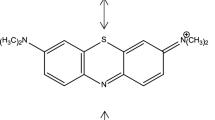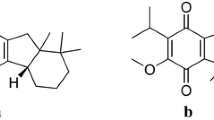Abstract
The effect of dimethylsulfoxide (DMSO) and diethylsulfoxide (DESO) on binding between quinine sulfate (QS) and DNA was studied by virtue of UV–Vis absorption, steady-state fluorescence spectroscopies, and fluorescence polarization measurements. The binding constant was determined at three different temperatures and the values of standard Gibbs energy change, enthalpy and entropy of binding were determined. The mechanism of binding and the effect of sulfoxides on this process was revealed. The values of binding constant, fluorescence polarization and iodide quenching studies confirmed that the main binding mode in QS-DNA system is groove binding. Addition of sulfoxides does not change the binding mechanism. Moreover, with addition of sulfoxides binding constant increases due to the removal of water molecules from DNA grooves making them more available for QS molecules. To explain the effect of DMSO and DESO on QS-DNA binding the photophysical properties of QS in aqueous solutions of DMSO and DESO were also studied. On the basis of quantum yield of QS in water, DMSO and DESO the types of intermolecular interactions were discussed. The obtained results show that quantum yield of QS in sulfoxides is lower compared with that in water and aqueous solution of 0.1 M H2SO4. QS forms ground state complexes with both DMSO and DESO that are stronger fluorophores compared with free QS molecules.







Similar content being viewed by others
Availability of Data and Materials
There are no available data and materials.
References
Zhong L, Li Y, Xiong L, Wang W, Wu M, Yuan T, Yang W, Tian C, Miao Z, Wang T, Yang S (2021) Small molecules in targeted cancer therapy: advances, challenges, and future perspectives. Sig Transduct Target Ther 6:201–1–48
Wu Y, Yang Z, Cheng K, Bi H, Chen J (2022) Small molecule-based immunomodulators for cancer therapy. Acta Pharmaceutica Sinica B 12(12):4287–4308
Han J, Perez J, Schafer A, Cheng H, Peet N, Rong L, Manicassamy B (2018) Influenza virus: Small molecule therapeutics and mechanisms of antiviral resistance. Curr Med Chem 25(38):5115–5127
Lei S, Chen X, Wu J, Duan X, Men K (2022) Small molecules in the treatment of COVID-19. Sig Transduct Target Ther 7:387–1–39
Sirajuddin M, Ali S, Badshah A (2013) Drug–DNA interactions and their study by UV–Visible, fluorescence spectroscopies and cyclic voltammetry. J Photochem Photobiol B 124:1–19
Patrick GL (2013) Introduction to Medicinal Chemistry. 5th ed. Oxford University Press
Kumar CV, Asuncion EH (1993) DNA binding studies and site selective fluorescence sensitization of an anthryl probe. J Am Chem Soc 115:8547–8553
Rohs R, Sklenar H, Lavery R, Rolder B (2000) Methylene blue binding to DNA with alternating GC base sequence: A modeling study. J Am Chem Soc 122:2860–2866
Tong C, Hu Z, Wu J (2010) Interaction between methylene blue and calf thymus deoxyribonucleic acid by spectroscopic technologies. J Fluoresc 20:261–267
Ulitzur S, Weiser I (1981) Acridine dyes and other DNA-intercalating agents induce the luminescence system of luminous bacteria and their dark variants. Proc Natl Acad Sci USA 78(6):3338–3342
Amado AM, Pazin WM, Ito AS, Kuzmin VA, Borissevitch IE (2017) Acridine orange interaction with DNA: Effect of ionic strength. Biochim Biophys Acta 1861:900–909
Bazhulina NP, Nikitin AM, Rodin SA, Surovaya AN, Kravatsky YuV, Pismensky VF, Archipova VS, Martin R, Gursky GV (2009) Binding of Hoechst 33258 and its derivatives to DNA. J Biomol Struct Dyn 26(6):701–718
Guan Y, Shi R, Li X, Zhao M, Li Y (2007) Multiple binding modes for dicationic hoechst 33258 to DNA. J Phys Chem B 111(25):7336–7344
Shahinyan GA, Ghazoyan HH, Markarian SA (2023) The effect of dimethylsulfoxide (or Diethylsulfoxide) on methylene blue-calf thymus DNA binding in aqueous solutions by fluorescence polarization and steady-state fluorescence quenching. J Solution Chem 52(6):708–719
Amirbekyan KYu, Shahinyan GA, Ghazoyan HH, Sargsyan HR, Markarian SA (2020) Fluorescence anisotropy studies on the Hoechst 33258-DNA interaction: the solvent effect. J Biomol Struct Dyn 38:4902–4906
Shirly Treasa M, DrJ P (2018) Characterisation and solubility studies of Quinine sulphate and Hydroxychloroquine sulphate inclusion complexes with α – cyclodextrin. IOSR J Appl Chem 11:24–34
Shoara AA, Slavkovic S, Donaldson LW, Johnson PE (2017) Analysis of the interaction between the cocaine-binding aptamer and its ligands using fluorescence spectroscopy. Can J Chem 95:1253–1260
Lai X, Lin Y, Zhang C, Zhou X (2013) Study on the interaction between quinine sulfate and DNA by multiple spectral methods and their analytical applications. Anal Sci 29:435–440
Patil DT, Bhattar SL, Kolekar GB, Patil SR (2011) Spectrofluorimetric studies of the interaction between quinine sulfate and riboflavin. J Solution Chem 40:211–223
Joshi S, Pant DD (2012) Solvent effects on the absorption and fluorescence spectra of quinine sulphate: Estimation of ground and excited-state dipole moments. AIP Conf Proc 1447:201–202
Kristoffersen AS, Erga SR, Hamre B, Frette Ø (2018) Testing fluorescence lifetime standards using two-photon excitation and time-domain instrumentation: Fluorescein, quinine sulfate and green fluorescent protein. J Fluoresc 28:1065–1073
Barrow DA, Lentz BR (1994) Quinine as a fluorescence lifetime standard: conditions for effectively homogeneous decay. Chem Phys Lett 104:163–167
Meech SR, Phillips D (1983) Photophysics of some common fluorescence standards. J Photochem 23:193–217
Pant D, Tripathi HB, Pant DD (1992) Time resolved fluorescence spectroscopy of quinine sulphate, quinidine and 6-methoxyquinoline: pH dependence. J Lumin 51:223–230
Joshi S, Varma T, Pant DD (2013) Steady state and time-resolved fluorescence spectroscopy of quinine sulfate dication in ionic and neutral micelles: Effect of micellar charge on photophysics. Colloids Surf A 425:59–67
Yadav SK, Rawat G, Pokharia S, Jit S, Mishra H (2019) Excited-state dynamics of quinine sulfate and its di-cation doped in polyvinyl alcohol thin films near silver nanostructure islands. ACS Omega 4:5509–5516
Yu Z-W, Quinn PJ (1994) Dimethyl sulphoxide: a review of its applications in cell biology. Biosci Rep 14:259–281
Jacob SW, Herschler R (1986) Pharmacology of DMSO. Cryobiology 23:14–27
Shahinyan GA, Amirbekyan AYu, Markarian SA (2019) Photophysical properties of methylene blue in water and in aqueous solutions of dimethylsulfoxide. Spectrochim Acta A 217:170–175
Markarian SA, Shahinyan GA (2015) The effect of dimethylsulfoxide on absorption and fluorescence spectra of aqueous solutions of acridine orange base. Spectrochim Acta A 151:662–666
Markarian SA, Gabrielyan LS (2007) Dielectric relaxation study of diethylsulfoxide/water mixtures. Phys Chem Liq 47:311–321
Ghazoyan HH, Grigoryan ZL, Gabrielyan LS, Markarian SA (2019) Study of thermodynamic properties of binary mixtures of propionitrile with dimethylsulfoxide (or diethylsulfoxide) at temperatures from (298.15 to 323.15)K. J Mol Liq 284:147–156
Markarian SA, Terzyan AM (2007) Surface tension and refractive index of dialkylsulfoxide + water mixtures at several temperatures. J Chem Eng Data 52:1704–1709
Markarian SA, Asatryan AM, Zatikyan AL (2005) Volumetric properties of aqueous solutions of diethylsulfoxide at temperatures from 298.15 K to 343.15 K. J Chem Thermodyn 37:768–777
Markarian SA, Asatryan AM, Grigoryan KR, Sargsyan HR (2006) Effect of diethylsulfoxide on the thermal denaturation of DNA. Biopolymers 82:1–5
Torreggiani A, Di Foggia M, Manco I, De Maio A, Markarian SA, Bonora S (2008) Effect of sulfoxides on the thermal denaturation of hen lysozyme: a calorimetric and Raman study. J Mol Struct 891:115–122
Markarian SA, Poladyan AA, Kirakosyan GR, Trchounian AA, Bagramyan KA (2002) Effect of diethylsulphoxide on growth, survival and ion exchange of Escherichia coli. Lett Appl Microbiol 34:417–421
Markarian SA, Ghazoyan HH, Sargsyan HR, Shahinyan GA (2019) Thermodynamic and spectroscopic (UV–Vis, FT IR) studies of solutions of CoCl2 (or NiCl2) in diethylsulfoxide. J Solution Chem 48(10):1378–1392
Markarian SA, Papanyan ZK, Shahinyan GA (2020) Volumetric, UV–Vis and FT IR studies of isoniazid in diethylsulfoxide solutions. J Solution Chem 49(7–8):1094–1106
Markarian SA, Grigoryan JD, Sargsyan HR (2008) The spectrophotometric study of the binding of vitamin E to water + dimethyl sulfoxide and water + diethyl sulfoxide containing reversed micelles. Int J Pharm 353:52–55
Punihaole D, Workman RJ, Upadhyay S, Van Bruggen C, Schmitz AJ, Reineke TM, Frontiera RR (2018) New insights into quinine–DNA binding using raman spectroscopy and molecular dynamics simulations. J Phys Chem B 122(43):9840–9851
Zhang Y, Zhang G, Fu P, Ma Y, Zhou J (2012) Study on the interaction of triadimenol with calf thymus DNA by multispectroscopic methods and molecular modeling. Spectrochim Acta A 96:1012–1019
Morawska K, Jedlińska K, Smarzewska S, Metelka R, Ciesielski W, Guziejewski D (2019) Analysis and DNA interaction of the profluralin herbicide. Environ Chem Lett 17:1359–1365
Markarian SA, Tadevosyan N (2002) Method of purification of diethyl sulfoxide. Patent of Republic of Armenia, No, p 20010041
Taniguchi M, Jonathan SL (2018) Database of absorption and fluorescence spectra of >300 common compounds for use in photochemCAD. Photochem Photobiol 94(2):290–327
Hajian R, Shams N, Mohagheghian M (2009) Study on the interaction between doxorubicin and deoxyribonucleic acid with the use of methylene blue as a probe. J Braz Chem Soc 20:1399–1405
Lakowisz JR (2006) Principles of Fluorescence Spectroscopy, 3rd edn. Springer, New York
Basu P, Kumar GS (2014) Elucidation of the DNA binding specificity of the natural plant alkaloid chelerythrine: A biophysical approach. J Photochem Photobiol B Biol 138:282–294
Lee S, Sung D-B, Kang S, Parameswaran S, Choi J-H, Lee JS, Han MS (2019) Development of human serum albumin selective fluorescent probe using thieno[3,2-b]pyridine-5(4H)-one fluorophore derivatives. Sensors 19:5298–1–13
Markarian SA, Stockhausen M (2000) Dielrctric relaxation of diethylsulfoxide. Z Naturforsch 55a:667–668
Gabrielian LS, Markarian SA (2004) Temperature dependence of the dielectric relaxation of liquid dimethyl- and diethylsulfoxides. J Molec Liq 112:137–140
Hajian R, Hossaini P, Mehrayin Z, Woi PM, Shams N (2017) DNA-binding studies of valrubicin as a chemotherapy drug using spectroscopy and electrochemical techniques. J Pharm Anal 7:176–180
Chaires JB (2008) Calorimetry and Thermodynamics in Drug Design. Annu Rev Biophys 37:135–151
Hajian R, Huat TG (2013) Spectrophotometric studies on the thermodynamics of the ds-DNA interaction with irinotecan for a better understanding of anticancer drug-DNA interactions. J Spectrosc 20:1–8
Husain MA, Ishqi HM, Sarwar T, Rehman SU, Tabish M (2017) Interaction of indomethacin with calf thymus DNA: a multi-spectroscopic, thermodynamic and molecular modelling approach. Med Chem Commun 8:1283–1296
Hu Z, Tong C (2007) Synchronous fluorescence determination of DNA based on the interaction between methylene blue and DNA. Anal Chim Acta 587:187–193
Acknowledgements
The work was supported by the Science Committee of RA, in the frames of the research project № 21T‐1D026.
Author information
Authors and Affiliations
Contributions
S.A. Markarian—the objectives of the problems, explanation of obtained results. G.A. Shahinyan—experiments, explanation of obtained results. All authors reviewed the manuscript.
Corresponding author
Ethics declarations
Ethical Approval
This declaration is “not applicable”.
Consent for Publication
Not applicable.
Consent to Participate
Not applicable.
Competing Interests
The authors declare that they have no known competing financial interests or personal relationships that could have appeared to influence the work reported in this paper.
Additional information
Publisher's Note
Springer Nature remains neutral with regard to jurisdictional claims in published maps and institutional affiliations.
Rights and permissions
Springer Nature or its licensor (e.g. a society or other partner) holds exclusive rights to this article under a publishing agreement with the author(s) or other rightsholder(s); author self-archiving of the accepted manuscript version of this article is solely governed by the terms of such publishing agreement and applicable law.
About this article
Cite this article
Shahinyan, G.A., Markarian, S.A. The Study of the Effect of Dimethylsulfoxide (or Diethylsulfoxide) on Quinine Sulfate-DNA Binding by UV–Vis and Steady-State Fluorescence Spectroscopies. J Fluoresc (2023). https://doi.org/10.1007/s10895-023-03442-6
Received:
Accepted:
Published:
DOI: https://doi.org/10.1007/s10895-023-03442-6




